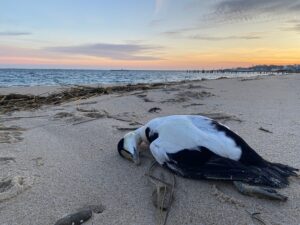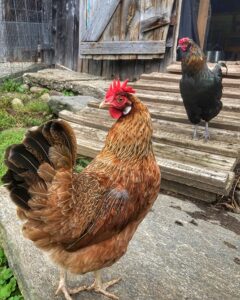WELLFLEET — If you feel like you’ve been noticing a lot of dead birds lately, you’re not alone. According to State Ornithologist Andrew Vitz, we are in the midst of the worst outbreak of Highly Pathogenic Avian Influenza — also known as H5N1 or bird flu — in state history. Its effect is being seen on wild birds, including here on Cape Cod, particularly on waterfowl.

Bird flu has been present in Massachusetts since 2022, but the current wave is exceptional, Vitz said in an interstate agency press conference on Jan. 29. He estimated that 500 to 1,000 birds killed by the virus had been reported to the Mass. Div. of Fisheries and Wildlife so far, but that the actual number of bird flu cases “is much higher than that.”
This high concentration in the state’s wild bird population, particularly in waterfowl and raptors, is also beginning to affect domestic chickens — though not yet on Cape Cod. Before this year, fewer than 10 chickens had been recorded contracting bird flu in the state, Mass. Dept. of Agricultural Resources (MDAR) Commissioner Ashley Randle told the Independent. But in January, bird flu appeared in a flock of 30 chickens in Plymouth County, killing 20. State officials destroyed the rest to prevent further spread.
Bird flu has not been detected in humans in Massachusetts, but nationwide there have been 67 cases since the beginning of 2024, including one death, according to the Centers for Disease Control website. The risk of humans contracting bird flu from birds remains low, according to the CDC, as all but three cases nationwide could be traced to exposure to infected poultry or cattle — and humans cannot spread it to each other.
Barnstable County’s Dept. of Health and Environment issued a public health advisory on Jan. 30 “to heighten awareness around avian influenza.”
Awareness is, at this point, the watchword. “We feel that awareness is the right approach as opposed to alarm,” said State Epidemiologist and Public Health Veterinarian Catherine Brown
at the Jan. 29 press conference.
Protecting Poultry and Pets
Why the incidence of bird flu is spiking is not clear, but Vitz said it could be tied to this year’s cold weather. With ponds frozen, our region’s waterfowl are congregating in fewer patches of open water, he said, making the spread of disease easier.

It is from infected wild flocks that poultry are at risk of being infected, Randle said. The disease is transferred through feces, feathers, saliva, and the bodies of birds that have died from the disease. “Water sources are especially a risk factor,” she said, since waterfowl are drawn to them, and the disease can remain in the environment long after infected birds have left.
Poultry owners should remove sources of standing water from their properties whenever possible, Randle said, and keep chickens away from ponds and other bodies of water that could be visited by wild birds. She also said that poultry should be prevented from free ranging to avoid exposure.
Bird flu has a nearly 100-percent fatality rate in poultry and spreads easily within a flock, Randle said. Once it hits a flock, “you do have to depopulate them,” she said. That is, the entire flock must be euthanized.
So far, apart from the one flock in Plymouth County, there have been no other reports of infected flocks in the state, Randle said. She noted that her agency has not implemented comprehensive surveillance of the disease in poultry but is currently focused on educating farmers and hobby owners about preventing the disease’s spread.
Elsewhere in the country, bird flu has made the jump to dairy cattle, where Randle said the disease is less fatal. But because bird flu can be transmitted through milk, Randle said, MDAR instituted mandatory monthly testing across the state’s 95 dairy farms last August, with 100 percent of results coming back negative so far.
Pets are susceptible to bird flu, particularly cats. “Domestic cats are very susceptible to this avian flu when they are exposed to it and tend to become seriously ill from the disease,” veterinarian Brown said at the Jan. 29 press conference. She recommended that people keep cats and dogs away from all dead birds and from raw food, particularly raw milk and raw poultry.
Increased Surveillance
The avian flu in its current form has a low chance of infecting people. “This is an animal virus right now,” Brown said. “It has not mutated in a way that it can affect people easily.”
Nonetheless, the state is ramping up surveillance efforts for the virus. According to a Feb. 3 letter sent to Outer Cape Health Services by the Mass. Dept. of Public Health, the state is issuing new guidelines for clinics to help detect the disease. It directs hospitals and clinics to perform tests on samples from patients with influenza A to identify the disease’s subtype, which is particularly important data when it’s from patients who are critically ill.
Samples that are not showing the common flu virus subtypes H1 or H3 will be expedited to the state public health laboratory for testing, as are samples from patients who report having been exposed to a sick or dead bird or dairy cattle. The state lab also wants samples from patients who have both conjunctivitis and influenza A symptoms, according to the letter.
Outer Cape Health Services Chief Population Health Officer Marie Constant, who gave the letter to the Independent, said that OCHS is communicating with state and local partners to determine how to implement the recommended measures. Constant said OCHS will have a statement about the enhanced bird flu surveillance available by Friday, Feb. 7.
Wild Birds at Risk
Among the wild birds getting hit hardest are geese and swans, said Vitz. The highest concentration of fatalities is along the shore — in both Greater Boston and southeastern Massachusetts.
Raptors are also at risk, particularly bald eagles, since many of them will consume dead waterfowl during the winter, Vitz said. Bird flu has been found in dead bald eagles in Massachusetts in the past, he said.
Locally, bird flu has been appearing in more wild birds brought to the Wild Care animal rehabilitation center in Eastham, according to Executive Director Stephanie Ellis. In 2024, only 3 percent of the waterfowl Wild Care took in tested positive for bird flu. So far this year, that number is 20 percent, and 15 percent of other non-songbirds and doves that Wild Care has taken in since Dec. 1, 2024 have tested positive for bird flu. Some birds have been able to recover when given food, fluids, and antibiotics, Ellis said.
According to the Cornell Lab of Ornithology’s All About Birds website, songbirds transmit the disease less effectively, limiting its spread. Of the over 10,000 wild birds nationwide that have tested positive for this avian flu, only 3 percent have been songbirds.
“For these reasons, it is unlikely that bird feeders will contribute to an outbreak among songbirds,” the website says. The only exception is if you also keep chickens: keeping domestic and wild birds apart is important.
Vitz encouraged the public to report dead birds to the Mass. Div. of Fisheries and Wildlife, particularly if there are five or more dead birds in one location. He also advised people not to touch any dead birds.
